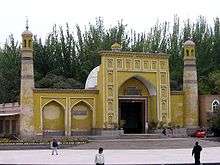Id Kah Mosque
- For the mosque in Afghanistan, see Id Gah Mosque
| Id Kah Mosque 艾提尕尔清真寺 | |
|---|---|
 | |
| Basic information | |
| Location | Kashgar, China |
| Geographic coordinates | 39°28′20″N 75°59′03″E / 39.47227°N 75.984106°ECoordinates: 39°28′20″N 75°59′03″E / 39.47227°N 75.984106°E |
| Affiliation | Islam |
| Region | Xinjiang |
| Ecclesiastical or organizational status | Mosque |
| Architectural description | |
| Architect(s) | Saqsiz Mirza |
| Architectural type | Mosque |
| Completed | 1442 |
| Specifications | |
| Capacity | 20,000 |
| Minaret(s) | 3 |
The Id Kah Mosque (Uyghur: ھېيتگاھ مەسچىتى, Хейтгах Месчити Hëytgah Meschiti, Chinese: 艾提尕尔清真寺; pinyin: Àitígǎěr Qīngzhēnsì) (from Persian: عیدگاه Eidgāh, meaning Place of Festivities) is a mosque located in Kashgar, Xinjiang, China.
History
It is the largest mosque in China. Every Friday, it houses nearly 10,000 worshippers and may accommodate up to 20,000.[1]
The mosque was built by Saqsiz Mirza in ca. 1442 (although it incorporated older structures dating back to 996) and covers 16,800 square meters.
In 1933, on August 9, the Chinese Muslim General Ma Zhancang killed and beheaded the Uighur leader Timur Beg, displaying his head on a spike at Id Kah mosque.[2][3][4][5]
In March 1934, it was reported that the Uighur emir Abdullah Bughra was also beheaded, the head being displayed at Id Kah mosque.[6][7]
In April 1934, the Chinese Muslim general Ma Zhongying gave a speech at Id Kah Mosque in Kashgar, telling the Uighurs to be loyal to the Republic of China Kuomintang government at Nanjing.[8][9][10]
On 30 July 2014, the imam of the mosque, hotelier Jume Tahir, was stabbed to death shortly after attending morning prayers.[11][12]
See also
- Islam in China
- List of mosques in China
- List of famous mosques
- Timeline of Islamic history
- Islamic architecture
- Islamic art
References
- ↑ Peter Neville-Hadley. Frommer's China. Frommer's, 2003. ISBN 978-0-7645-6755-1. Page 302.
- ↑ S. Frederick Starr (2004). Xinjiang: China's Muslim borderland. M.E. Sharpe. p. 77. ISBN 0-7656-1318-2. Retrieved 2010-06-28.
- ↑ James A. Millward (2007). Eurasian crossroads: a history of Xinjiang. Columbia University Press. p. 198. ISBN 0-231-13924-1. Retrieved 2010-06-28.
- ↑ Andrew D. W. Forbes (1986). Warlords and Muslims in Chinese Central Asia: a political history of Republican Sinkiang 1911–1949. Cambridge, England: CUP Archive. p. 93. ISBN 0-521-25514-7. Retrieved 2010-06-28.
- ↑ The British newspaper The Times reported that a turki chief was beheaded on August 25, 1933
- ↑ Christian Tyler (2004). Wild West China: the taming of Xinjiang. New Brunswick, New Jersey: Rutgers University Press. p. 116. ISBN 0-8135-3533-6. Retrieved 2010-06-28.
- ↑ Andrew D. W. Forbes (1986). Warlords and Muslims in Chinese Central Asia: a political history of Republican Sinkiang 1911–1949. Cambridge, England: CUP Archive. p. 123. ISBN 0-521-25514-7. Retrieved 2010-06-28.
- ↑ S. Frederick Starr (2004). Xinjiang: China's Muslim borderland. M.E. Sharpe. p. 79. ISBN 0-7656-1318-2. Retrieved 2010-06-28.
- ↑ James A. Millward (2007). Eurasian crossroads: a history of Xinjiang. Columbia University Press. p. 200. ISBN 0-231-13924-1. Retrieved 2010-06-28.
- ↑ Andrew D. W. Forbes (1986). Warlords and Muslims in Chinese Central Asia: a political history of Republican Sinkiang 1911–1949. Cambridge, England: CUP Archive. p. 124. ISBN 0-521-25514-7. Retrieved 2010-06-28.
- ↑ http://www.bbc.co.uk/news/world-asia-china-28586426
- ↑ James T. Areddy (31 July 2014). "State-Appointed Muslim Leader Killed in China". The Wall Street Journal. Retrieved 1 August 2014.
External links
| Wikimedia Commons has media related to Id Kah Mosque. |

